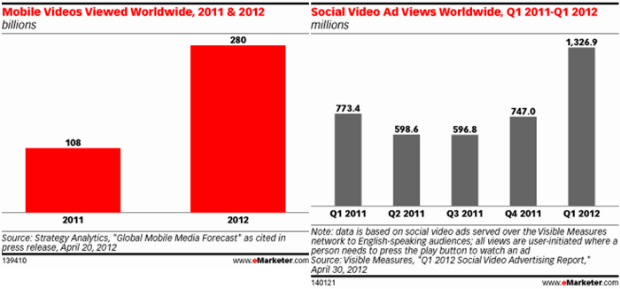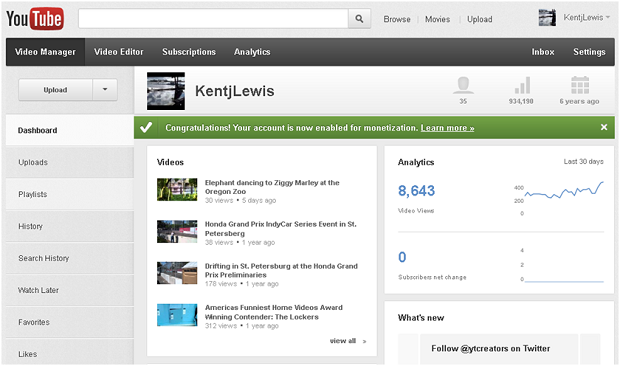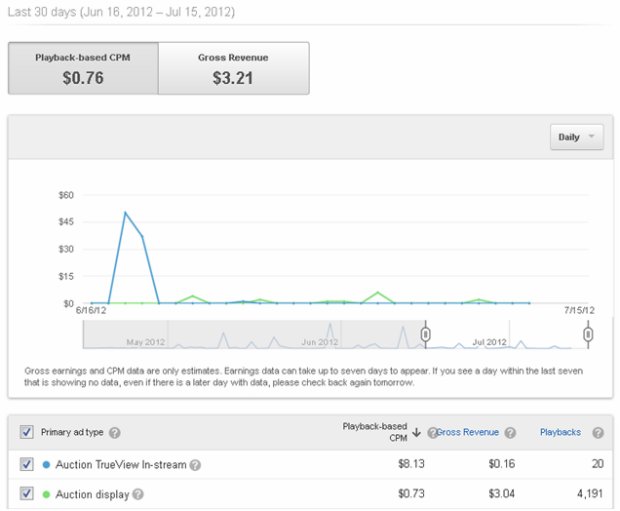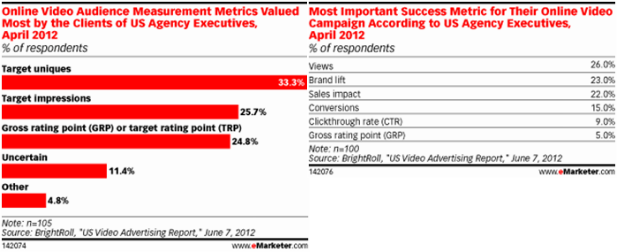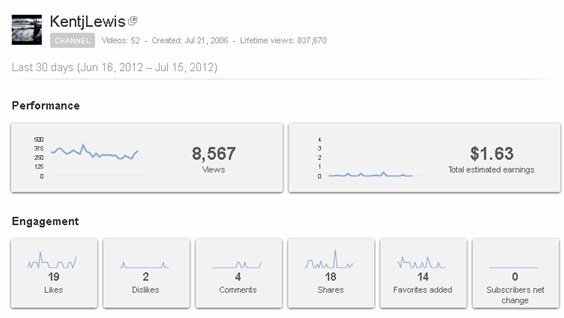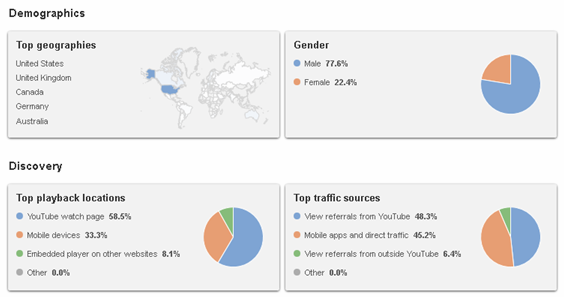The ultimate guide to video marketing on YouTube
Kent Lewis
Video is the undisputed darling of the marketing world in 2012. According to the Cisco VNI Benchmark Report, global internet video traffic will make up 54 percent of all consumer internet traffic in 2016 — up from 51 percent in 2011. Globally, internet video to TV doubled in 2011, while video-on-demand traffic will triple by 2016. In 2011, Strategy Analytics cited 108 billion mobile videos were viewed worldwide; in 2012 that number has already climbed to 280 billion views. Video offers greater retention and recall — up to five times greater than the written word. While the statistics are intriguing and exhaustive, the back story is even more compelling.
Why video?
There are a variety of reasons web-based video is such an important media vehicle, and marketers that understand the nuances will be more successful than the laggards. For starters, video is one of the most efficient and highest life form of media. A 30-second HD video offers four powerful media form factors to marketers: video, audio (podcast), text (transcript), and still images. Each of these form factors can be edited, optimized, syndicated, and promoted across a variety of platforms, including YouTube, iTunes, websites, blogs, Pinterest, and Flickr.
Another compelling reason for marketers to pay attention to video: YouTube is the second most popular search engine by volume. That means your customers are using YouTube to for research in addition to or in lieu of Google, Bing, or Yahoo, This change in behavior provides a new opportunity for marketers: To create a dedicated TV channel on YouTube, complete with original programming and advertising. To be truly effective, a YouTube channel should contain videos for all four stages of the sales cycle: awareness, interest, intent, and purchase. I’ll go deeper into this in a moment.
Video provides the ultimate storytelling medium: If a picture is worth 1,000 words, then how many words is a 30-second video worth at 30 frames a second? Consumers and new organizations alike are catching onto this trend. According to recent research, for the 14 months between January 2011 to March 2012, the most searched-for terms on YouTube were related to news events. For example, the Japanese earthquake and tsunami was the most popular news event on the video network: In the week following the disaster (March 11 to 18), the 20 most-viewed videos related to the tragedy were viewed more than 96 million times.
As an advertising vehicle, video is equally powerful: Online video ads outperform other online ad formats. According to eMarketer, U.S. online video advertising spending will grow 52.1 percent to $2.16 billion in 2011, before reaching $7.11 billion in 2015. Online video’s ad spending growth will far outstrip TV’s growth through 2016. The charts below paint a clear picture for the future of online video advertising:
WhoTube?
YouTube rules the roost of video sharing sites on the internet, but there are alternatives to the Google juggernaut. Although Revver closed its doors earlier this year, a few players continue to give users options. One of the largest third party video sharing sites around today is Vimeo (which recently announced a partnership with Pinterest). Familiar brands like Flickr, Photobucket, and Yahoo offer video services while newer video-centric sites — like blip, Chill, Dailymotion, and metacafe — continue to fight for market share. If your business is a natural for video marketing, consider testing the alternative video platforms in addition to YouTube. Platforms like TubeMogul offer the ability to edit, upload, manage, and track videos across multiple platforms.
Video marketing best practices
Having developed video marketing strategies for a host of Anvil Media clients, we’ve had the opportunity to test and refine our best practices. Below is a list of recommendations to consider when developing a successful video marketing program, from strategic planning to measurement.
- Benchmark the competition (analyze profile design, overall content, and level of interaction)
- Based on analysis of existing videos, the ideal duration to maximize engagement is 30 to 120 seconds
- All videos should include a closing call-to-action (visit a website, subscribe, comment, share, etc.)
- For trademarked or copyrighted content or improved measurability, consider digital watermarking
- Create a text transcript for all videos (good for search engine optimization and ADA compliance)
- Create an audio-only “podcast” for distribution on iTunes and other audio websites
- Create still images from HD videos to post on Pinterest, Flickr, Facebook, and other profiles
- Don’t forget to set default sharing option to “public” or “allow all”
- Use comments, hot spots, and A/B Testing as your virtual focus group (to determine future content and format ideas)
- Based on new posting rules recently released by YouTube, be sure to use your Google+ profile when commenting on videos
Video optimization essentials
The old adage, “if a tree falls in the forest and nobody is there to hear it, does it make a sound?” applies to internet video — uploading a video to YouTube does not translate into views, let alone coverage in The New York Times or an appearance on “The Tonight Show.” To ensure your video content production efforts are worthwhile, it is essential to develop an optimization and promotion program. Below are a few fundamental video optimization strategies:
- Incorporate relevant keywords into your overall account profile
- Embed keywords into each video filename, title, and description (don’t forget the term “video”)
- Include a relevant URL at the front of the video description
- Add descriptive “tags” to videos if available (consider using “quotes” around targeted terms)
- Properly categorize your video for optimal visibility in each platform’s directory
- Select a thumbnail that reflects the content of the video yet is also compelling
By keeping the above optimization fundamentals in mind as you create and upload videos, you’ll maximize the opportunity for each video to be seen by the target audience. Uploading the videos is just the beginning, however. We’ll discuss promotional strategies a bit later.
YouTube essentials
No video marketing guide would be complete without a dedicated YouTube section. The reasoning is clearly justified by the numbers:
- Sixty hours of video uploaded every minute
- Over 4 billion videos are viewed a day
- YouTube Mobile gets 400 million views a day
- Seventy percent of YouTube traffic comes from outside the US
- Localized in 39 countries and across 54 languages
- In 2011, 1 trillion views (nearly 140 views per person)
- U.S. consumers exposed to a YouTube homepage ad are 437 percent more likely to engage in a key brand activity on the same day than those unexposed
YouTube channel creation
Now that your boss has bought off on the investment in YouTube, the first step is to create an optimized profile (or channel). Every channel includes a standard set of features and functionality. The new Dashboard (below) provides easy access to key information and analytics relating to your account.
When creating your profile account, be sure to customize key elements, including the username (which may become part of the URL, channel description, About Me and Playlists (which now include start and end time editing). YouTube also offers intuitive uploading and editing features, including captioning and annotating capabilities. For high traffic or high value videos (as determined by YouTube) you may request or receive “monetization” status, which provides revenue share for any ads clicked on while visitors view your channel or specific videos (notice the green notification bar in my dashboard above).
YouTube best practices
There are a variety of best practices to leverage throughout the video creation, promotion, and measurement process. For starters, think globally, locally, and mobility: Translate videos to target markets globally, yet localize content when possible (particularly for retail businesses.) Don’t forget videos are often viewed on mobile devices, so adjust your creative accordingly and empower your team to upload videos via mobile device when in the field. During content development, consider repurposing existing content, including commercials, presentations, demos, how-to’s, interviews, etc. In the production stage, consider embedding URLs and calls-to-action into both the video (annotate) and the description. When uploading content, be sure to set your default settings to streamline the process. To maximize visibility and views, maintain good standing by following community guidelines, manage copyright strikes, and content ID claims. To further enhance viewership, incorporate a link to your YouTube profile and select videos into other social profiles, websites, newsletters, and signature files.
YouTube video content strategy
When developing content for your YouTube strategy, keep in mind that visitors look for videos that answer questions Google searches typically address. As such, create content for all four stages of the sales cycle: awareness, interest, intent, and purchase. For general awareness and interest, create interviews, timely news, and trend-based content. For the intent and purchase stages, create appropriate content including product demonstrations or comparisons, seminars, and success stories. For existing customers, develop relevant content like how-to’s, FAQs, and product updates.
Advertising on YouTube
YouTube offers a variety of vehicles to reach your target audiences. Before investing in advertising, however, start with the YouTube Keyword Tool, as it provides helpful demographic insights and global targeting capabilities. The YouTube Video Targeting Tool allows you to target relevant videos with In-Stream ads or Promoted Videos. YouTube In-Stream Ads are 30-second video clips that appear prior to relevant videos. YouTube Promoted Videos option highlights your video at the top of relevant search queries within YouTube. YouTube TrueView Video Ads offer viewers choice of which ads they view and in which format (Instream or the new InSlate option.)
YouTube analytics
What gets measured gets managed. Videos are no exception. Although YouTube provides fairly elaborate analytics platform, marketers are still challenged when it comes to metrics (see charts below).
As you can see, the primary metric according to agency executives, is views, followed by brand lift and sales impact. On the client side, target uniques and impression are most valued. Regardless, the analytics available on YouTube should provide adequate insights for all but the most advanced video marketers. The free metrics currently available via YouTube’s analytics platform include:
- Views
- Likes and dislikes
- Comments
- Favorites
- Watch later
- Subscribers
- Social sharing
- Insights
Of the above metrics, the most compelling from an engagement strategy include likes, comments, favorites, subscribers, and shares. Below are a few sample screen shots from my personal YouTube account. You can see the first chart (top left) highlights overall performance metrics for my channel. To the right of that chart is a demographic snapshot of channel visitors. The lower left and right images are two views of the analytics dashboard for an individual video, specifically engagement over time and relative to benchmarks. Before finalizing your key performance indicators (KPIs) for video marketing, consider reading my article on social metrics that truly matter.
Video promotion best practices
Regardless of where your videos reside, developing a consistent and scalable marketing process is essential. Be sure to incorporate the below best practices when promoting your videos, in order to maximize visibility and engagement.
- Video sitemap: Ensure your videos are properly indexed by search engines
- Embed and promote videos across webs properties, including websites, blogs, and social profiles (don’t forget Facebook tabs and LinkedIn company profile featured video)
- Text for context: When embedding into websites or blogs, surround the video with keyword-relevant copy
- Offline to online: Include URL to your channel or specific videos in print materials including advertising, direct response, event signage or PR materials (QR codes work well for this)
- Online: Embed URL into electronic communications, including email signature files, newsletters, PR, and advertising campaigns
A successful video marketing strategy should be driven by data. With a solid understanding of key metrics and preset benchmarks, a campaign is much more likely to be successful. For companies lacking internal resources, visit the YouTube Partners for a list of vendors (or drop me a line.) To ensure efficient distribution and measurement of videos across multiple platforms, I’ve included a selection of other helpful video marketing resources below. As they say in show business, break a leg!
Close

